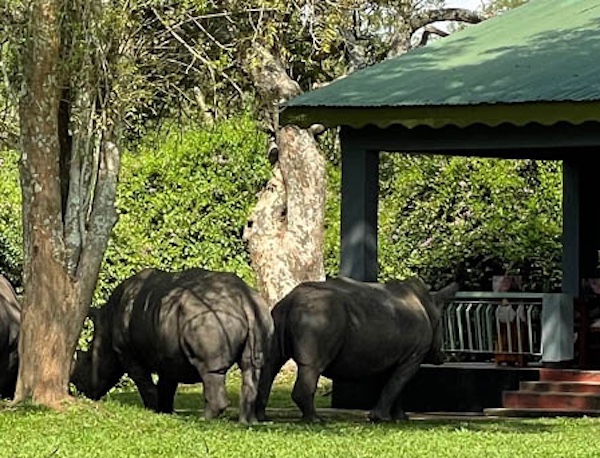Uganda’s wildlife heritage has taken a remarkable turn at Ziwa Rhino Sanctuary, a once-cattle-dominated ranch now home to the country’s only wild rhinos. This ambitious conservation project has revived the rhino population, offering hope for their future in Uganda.
From Cattle Ranch to Rhino Sanctuary
Ziwa ranch, a 27-square-mile (70-square-kilometer) expanse of grassland in central Uganda, was once home to 7,000 head of cattle. However, these domesticated animals have since been replaced by a much rarer and more endangered species: rhinoceroses. Today, Ziwa hosts the only rhinos living in their natural habitat in Uganda.
Historically, Uganda was home to both the black and northern white rhinos, with an estimated population of around 700. However, by the early 1980s, rampant poaching, wildlife trafficking, and political instability—particularly under the dictatorship of Idi Amin—led to their complete eradication from the country.
Determined to restore Uganda’s rhino population, Rhino Fund Uganda, a conservation charity, partnered with Captain Joseph Charles Roy, the owner of Ziwa cattle ranch. In a bold move, Roy agreed to phase out his cattle and convert the land into a rhino sanctuary. Between 2005 and 2006, six southern white rhinos were introduced to Ziwa—four transported overland from Kenya and two flown in from Disney’s Animal Kingdom in Florida via Roy’s own cargo airline.
Unexpected Success in Conservation
The decision to establish Ziwa as a rhino sanctuary has proven to be an extraordinary success. The sanctuary’s diverse ecosystem, comprising swamps, savannah, and woodland, has provided an ideal breeding ground. The initial six rhinos have multiplied into a thriving population of 48, with five calves born in just the last three months.
In stark contrast, two rhinos relocated to Uganda’s Wildlife Conservation Education Center (formerly Entebbe Zoo) at the same time have yet to produce any offspring. The success at Ziwa underscores the importance of providing an environment conducive to natural breeding and minimal stress for the animals.
A Conservation Model Built on Protection and Tourism
Ziwa’s conservation model is built on robust protection and sustainable tourism. The sanctuary employs dedicated rangers who provide 24/7 monitoring of each rhino family, recording vital behavioral data that contributes to global rhino conservation efforts. Poaching remains a significant threat, but Ziwa’s perimeter is actively patrolled to deter illegal activities.
Tourism plays a crucial role in sustaining Ziwa’s operations. Managed by Wendy Roy, daughter of Captain Roy, the sanctuary offers walking safaris that allow visitors to see rhinos up close. The sanctuary also hosts diverse wildlife, including leopards, antelopes, warthogs, and the rare shoebill stork. Revenue generated from tourism directly funds conservation efforts.
The Challenge of Expansion and Relocation
As Ziwa’s rhino population continues to grow, the sanctuary faces a pressing challenge: space. With a carrying capacity of around 70-80 rhinos, the sanctuary is nearing its limit. Plans are in place to introduce an additional eight rhinos from another African country to diversify the gene pool, further increasing population pressure.
To address this, the Ugandan Wildlife Authority (UWA) has been preparing Ajai Wildlife Reserve—136 miles (220 kilometers) northwest of Ziwa—for rhino reintroduction. Once a stronghold for white rhinos, Ajai has been undergoing restoration since 2021. However, progress has been hindered by funding shortages, challenges in relocating communities within park boundaries, and a lack of trained rangers.
Now, with renewed governmental support and a substantial budget, UWA aims to relocate around 20 rhinos from Ziwa to Ajai by February 2026. Efforts are underway to construct an electrified enclosure, restore vegetation, and recruit local community members as rangers to ensure their protection.
A Symbol of Uganda’s Wildlife Renaissance
Conservationists remain cautiously optimistic about the planned relocation. Dr. Gladys Kalema-Zikusoka, a leading veterinarian and wildlife conservationist, emphasizes that success will depend on robust security measures and sufficient ranger deployment to prevent poaching. If successful, Ajai could serve as a model for reintroducing rhinos into other national parks, such as Kidepo and Murchison Falls, further strengthening Uganda’s biodiversity and boosting wildlife tourism.
Beyond ecological benefits, the reintroduction of rhinos carries a deeper symbolic significance. Their extinction in Uganda mirrored the nation’s turbulent past, particularly during the reign of Idi Amin. Their return represents stability, resilience, and Uganda’s renewed commitment to wildlife conservation.
As Ziwa continues to thrive, the dream of a widespread rhino resurgence in Uganda inches closer to reality. With continued investment and protection, the country may soon reclaim its place as a sanctuary for these majestic creatures

